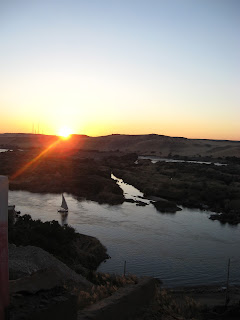Alfresco breakfast at sunrise in Nubia – hibiscus tea, juice, fresh bread and a nice omelet, courtesy of the chickens they keep right there.
Then it is back to the convoy and a 3 ½ hour drive back north to Aswan
In Aswan
The island has been inhabited from the Early Dynastic Period through Roman times through the present day. There are some well preserved temple ruins but we do not have time to see these. Maybe next time. Honestly at this point we are so saturated with temples and monuments, it would have been difficult to absorb any more.
We see traditional crops, fodder, narrow streets, and mud brick homes up to three stories high. In some places the home is on both sides of the street and there is a bridge at the second story level connecting the two parts of the home, as you can see above.
We had a very nice lunch with our host Mohamed who is the owner of Animalia House. His wife, a local math teacher, made and served the very ample amounts of food, to which we could not do justice. He gave us a great demonstration of all the ways Nubian people use date palms. The trunks made into sawed lumber, to frame their houses. The spines of the leaves make rattan that is fashioned into furniture, stiff baskets, fish traps, bird cages. The leaves are used to weave rope, mats, and flexible baskets - and of course there are dates to eat.
 |
Rattan furniture and bird cages, made from date palm leaf spines |
'
He showed us how Nubians surround the courtyard of their homes with very fine sand and sweep it smooth with a date palm broom. Then you can see if there has been a snake or scorpion crossing the sand by its tracks. There was a pet tortoise in the courtyard – charming creature.
 |
| Traditional Nubian "kitchen" |
Nubians comprise ad 300,000 to 400,000 population minority in a nation of 86 million. Mohamed’s museum included mineral samples, an insect collection including scorpions and scarabs, preserved fish including an electric fish, an enormous (four foot long) Nile perch, and a very ugly catfish that is considered too unclean to ever eat. Tilapia of three kinds are the main food fish from the river.
His reptile specimens included horned vipers, cobras, and a huge Nile crocodile, as well as a little two foot croc that he said were sometimes kept as pets. He also had stuffed animals like foxes and jackals, and birds like falcons and herons.
As we walked back to the riverside with our guide, he identified more plants including castor bean, and the type of fig tree that is part of the Osiris legend. This is a variety of strangler fig that will completely enclose its original host and the story in the myth involves a tree that grows around the coffin of Osiris in Syria Isis had to plead for it so she could reclaim her husband’s body.
We go back to Aswan
She must leave us to catch her train back to Cairo
We have more hibiscus tea, some cakes – there is a little gray tiger kitty and accepts some salty bread sticks as a gift. We wished we had something better to give him. We watch sunset and take pictures of the Nile at the first cataract and Elephantine Island
We were off to the night train where we have an unremarkble travel dinner served in heated foil packets in our compartment. We leave at 7 pm and eventually settle into our separate bunks – upper and lower. We sleep reasonably well on the scheduled 11-hour train and our thoughts are with Dalia sitting up in her 13-hour train making local stops along the way. Tomorrow it's Cairo.
more pictures from today are here: https://picasaweb.google.com/eloise.hedbor/20110125?authkey=Gv1sRgCILA_4nwg9vG2wE#





No comments:
Post a Comment